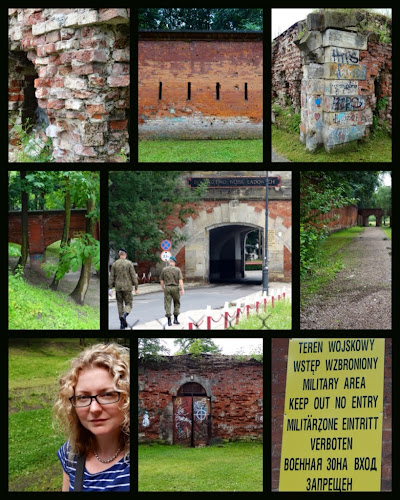In Warsaw we ate Pierogi and Bigos
(Dumplings and cabbage stew doesn't sound quite as good)
Greetings from Jereselam Avenue - on the first night I asked. Local at the hostel for a recommendation for dinner. (See above) He suggested a restaurant near Palm Tree. I some how hadn't notice the huge plastic tree on the walk from the station to the hostel. It is actually a monument to the Jews who are no longer in Warsaw and a reference to Tel Avive.
The building behind it is the old Polish Communist Party Headquarters it ironically became the Warsaw stock exchange until 2001 and now houses numerous businesses.
Our hostel was right by Savior Square. The rainbow installation was a symbol for peace and tolerance in society.
The Museum of The History of Polish Jews and the Holocaust Memorial
Warsaw Citadel. 19th century fortress that survived the war and is now Polish Army property.
Warsaw's Old Town Market Place.
Probably the nicest square I have visited on this trip. In the 1944 Warsaw Uprising, 85 percent of the buildings in this square were destroyed. The current buildings were reconstructed between 1948–1953 to look as they did in the 17th century. The Warsaw Mermaid is in the centre of the square.
The guidebook said to avoid the bars in the in The Old Town Square as they would be expensive. We ignored the guidebook and and paid the hefty £1.30 for a small beer.
Novomeijska Gate and The Old Town defensive walls from the sixteenth century.
The highlights of Castle Square
Royal Castle (Zamek Krolewski), an escalator and King Sigismund's Column (Kolumna Zygmunta)
Yes, that's right, an escalator. The tourist map I was following had it marked as a place to visit and being an obedient tourists I went. To quote the map...
"The first ESCALATOR in Warsaw, opened in 1949, is no longer a wonder of technology but its worth seeing - as a version of the lavish interiors of the Moscow metro. It was actually a gift from the Russian capital to Warsaw."
Tomb of the Unknown Soldier
Incredibly moving Monument to the Warsaw Uprising Fighters
Abandoned houses in Próżna Street. This building, which was inside the ghetto walls has apparently not been touched since 1945. There are lots of bullet holes visible. Portraits now hang from the boarded up windows.
We stumbled upon this outdoor gallery showing pictures of buildings around Warsaw in 1947.
Cmentarz Zydowski
I wasn't planning to take any photographs here as it somehow didn't seem appropriate. I changed my mind when I was walking round. The Jewish Cemetery is huge, it contains over 200,000 marked graves dating back to the early 1800s, an important reminder of a huge community that no longer exists. Many of these graves and crypts are overgrown, to the extent of becoming a forrest, having been abandoned as there was simply no community left to maintain the place.
The cemetery also contain the mass graves of victims of the Warsaw Ghetto, the Warsaw Ghetto Uprising, Warsaw Uprising of 1944 and other mass murders. There are some very moving monuments located here.
And the reason I changed my mind about taking pictures was that despite/because of the neglect it is a beautifully peaceful place. The photos do not communicate the tranquility and uniqueness of this place and the people buried here should be remembered.
Another gem from the tourist map...
"PEEK-A-BOO SKYSCRAPER - One of the weirdest looking buildings in the city – the 165 meter INTERCONTINENTAL HOTEL has a huge hole on its lower floors. It is not a whim of the architects, but a compromise with people living in a housing block behind it, who would otherwise be deprived of daylight in their flats."
Palace of Culture and Science
Originally known as Joseph Stalin Palace of Culture and Science built in 1952 as a gift from the Soviet Union to the people of Poland. Dominates the skyline and (in my opinion) ugly eye-saw on a beautiful city.
The Vistula River, The Siekierkowski bridge, The Warsaw Mermaid and the view across the river to the national stadium.
The University of Warsaw's Green Library.
Praga to the east of the Vistula River. Relatively undamaged in the war. It had a strange market with lots of stalls selling wedding dresses of all things.
The The Chopin Statue in Lazienki Park
The bench outside the park tells you all about the history of the statue and if you press a button on the bench it plays Chopin for you while you read.
Camera shy squirrel in Lazienki Park, there were lots of them scurrying about and were really tame.
More wildlife in Lazienki Park. (Apart from the pig, he was someone's pet and was being walked outside a block of flats)
All in all Warsaw was a fascinating city and I would love to come back to Poland to explore some more.






















